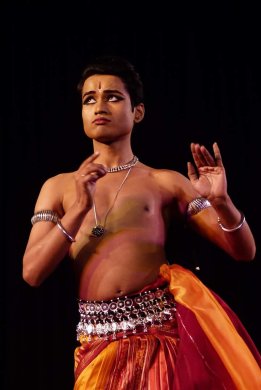
|   |

|   |
 e-mail: leelakaverivenkat@gmail.com Tantu needs more than hype and hurry February 15, 2017 It was called 'Tantu,' a "unique concept premiering a programme of Gurus Sharon Lowen, Madhavi Mudgal and the performer of the evening Madhur Gupta, framed by classics by the major architect of Odissi, Guru Kelucharan Mohapatra." Hype has become the tenor of this generation and young Madhur Gupta, true to this age, seems a man in a hurry. No matter what type of stringing together of items one designs, the ultimate test lies in the dancer's competence and here the dancer performing at the IIC auditorium, Delhi, left something to be desired. Right as he made an entry, his profiled body with head, neck, and back were not held in an erect line, the first requirement in a dancer. Apart from not holding the body straight, the shoulders and chest would not open out giving movement a spread. Whether it was the square geometrical motif of the chowk, or a diagonal walk with one leg weaving a circle in the air and being placed at the back of the other in a crossed foot swastika, Madhur's movements, all executed close to the body gave his Odissi a very constricted feel taking away from the nature of the form, which along with the extreme grace of the tribhanga also has the strong posture of the chowk. Madhur has a flexible torso which is a plus point and he seems to revel in the tribhanga position. But he must first bring to his movements the full range with the contrasts of grace and tandav which are so central to this dance form - learn to walk correctly before trying to run so to speak. In fact one did wonder at a person starting training under Madhavi Mudgal for a short time, as claimed (which Madhavi when contacted denied) having such inadequate anga shuddha.  Rajanigandha Pallavi, with the dance composed by Madhur himself, based on the Odiya Kedar musical composition of the music expert Bankim Sethi, was a bold attempt, for the Pallavi, apart from varied nritta patterns woven into the musical refrain, has to catch the spirit of the raga and music in a slow expansion from minimal to more intricate movements. Here the start with words like "sampoorna, ranga, suranga, dolita, taranga" brings out the raga rupa and lakshanas of the raga. One does not want to curb the adventurous spirit of a young dancer. But Madhur has some way to go, by learning many more Pallavis of Kelucharan Mohapatra to fully understand the spirit of this nritta centerpiece, before beginning to compose one. The abhinaya part of the programme showed promise. "Chagadi matra hela he Shyama," the champu wherein Lalita recognizing the giveaway signs of desire for Radha on Krishna's body, tries to distract him in vain. Madhur's interpretation (as designed in 2016 by Madhur's present Guru Sharon Lowen), caught the spirit of the song, the music in Misra Piloo by Prashant Kumar Behera also contributing. Even the fish, the deer and creatures of Nature remind Krishna of Radha's eyes and movement grace. Kumara Sambhavam choreographed by Sharon Lowen in 1992, caught a glimpse of Parvati after the wedding night shyly shielding herself from Shiva's eyes, wondering how to conceal love marks on her body from friends who will visit her. With segments of a Kelucharan Pallavi between interpretative parts, this cut and paste treatment, even if the movements were differently conceived, lost its 'sthayi' through constant nritta interruptions, and the dominant mood got diffused. The rendition of the ashtapadi "Yahi Madhava" reflected Radha's blend of a broken heart and anger at being jilted. While the basic emotive ability is there, Madhur's expressional range will grow and mature with the years even more. Shantam with the moksha finale as set by Kelucharan Mohapatra, had the final sloka exhorting peace in every sphere of this Universe, and while this ending note is Madhavi Mudgal's concept, one could not see any distinct choreographic features of hers the way it was presented. One is all for encouraging youngsters. But instead of the compere's superlatives and the entire hype surrounding the evening growing out of proportion with the young dancer's abilities, adopting a more sedately balanced presentational approach would be wiser.  Writing on the dance scene for the last forty years, Leela Venkataraman's incisive comments on performances of all dance forms, participation in dance discussions both in India and abroad, and as a regular contributor to Hindu Friday Review, journals like Sruti and Nartanam, makes her voice respected for its balanced critiquing. She is the author of several books like Indian Classical dance: Tradition in Transition, Classical Dance in India and Indian Classical dance: The Renaissance and Beyond. Post your comments Please provide your name and email id when you use the Anonymous profile in the blog to post a comment. All appropriate comments posted with name & email id in the blog will also be featured in the site. |